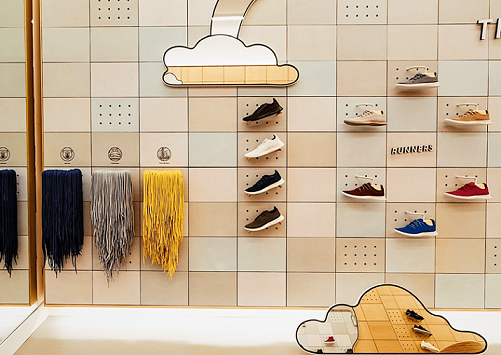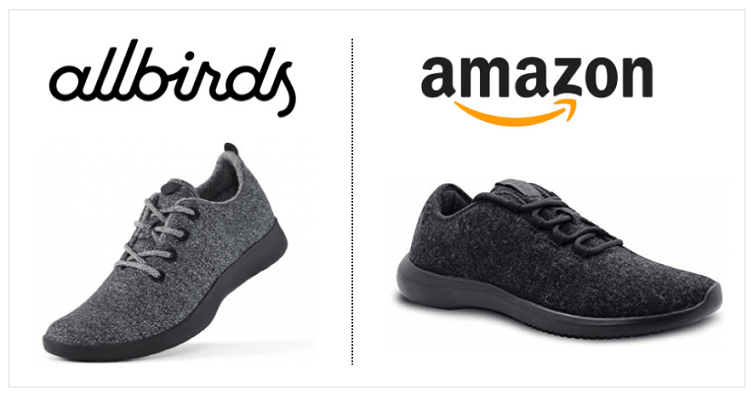 In late November, Joey Zwillinger, founder of direct-to-consumer (DTC) natural footwear brand Allbirds, revealed that Amazon launched a near-identical private label trainer. This could come as a bit of shock to marketers and brand managers alike.
In late November, Joey Zwillinger, founder of direct-to-consumer (DTC) natural footwear brand Allbirds, revealed that Amazon launched a near-identical private label trainer. This could come as a bit of shock to marketers and brand managers alike.
But should anyone actually be that surprised?
This isn’t the first time we’ve seen Amazon launch private-label products to take on established market leaders; Amazon Basics batteries aggressively lined-up against Duracell, private-level Mama Bear Wipes pitted against family-favourite Johnson’s, whilst a high-profile lawsuit is underway by West Elm’s parent company Williams-Sonoma over a replica of one of its designer dining chairs. The likeness is uncanny.
It doesn’t take a sneakerhead to see the similarities between the Allbirds Wool Runner and Amazon’s new 206 Collective sneaker; both feature a wool upper with similar colourways and subtle branding. Perhaps the bitter pill to swallow for the team at Allbirds isn’t the design similarities, but that Amazon have aggressively positioned its alternative at half the cost (US$45) of their equivalent (US$95). Many could argue that Allbirds’ quality and sustainable manufacturing practices are worth the premium, but it’s hard to argue that the difference in pricing won’t be attractive to Amazon’s core audience and consumers who are happy to accept a trade-off in branding in order to still wear something on-trend, especially with a savings of over 50 percent.
Make no mistake, Amazon launched its trainer after seeing a clear demand from what customers were searching for within its ecosystem, possibly additionally motivated by Allbirds’ refusal to work with retailers and marketplaces as part of its sole DTC strategy. Amazon is merely fulfilling a gap in its product offering and is answering consumer demand.
Unsurprisingly, Amazon’s wool blend sneakers are sold out a mere week and a half after going live.
Is Amazon alone in launching copycat products?
Whilst brands and retailers alike can express outrage and paint Amazon in a bad light over this and other similar examples, Publicis Media’s Head of Marketplaces, Jason Wescott, reminds us that this behaviour is an established and common practice within retail. “Amazon copying an Allbirds design is no different to Zara basing a trainer on a Gucci shoe or a River Island releasing sneakers that look like Yeezys,” Westcott said. “This is fundamentally how fashion works and design trends introduced by exclusive high fashion and innovative challenger brands are copied, from a subtle influence to the virtual replica, as the rule and not the exception.”
This can be witnessed in even greater frequency in sectors such as grocery, where supermarket brands have been eroding away premium household names with copycat products for decades. Perhaps Amazon has caught many off-guard due to the rapid pace and scale it’s able to achieve, not to mention the firepower of its marketing efforts.

What can CPG brands learn from this?
Innovate-or-die is an overused cliché in the marketing world, but in the case where many consumer-packaged goods (CPG) are so easily copied – and factors like pricing and delivery speed play a vital role in determining a sale – brands really need to think about what incremental benefits can be added to their propositions and product catalogues to offer the consumer more than just a commodity.
“When brand is not a primary purchase trigger and products become commodities, like-for-like products are chosen on price – something Amazon does exceedingly well,” said Wescott.
As Amazon continues to grow its dominance in CPG and fast-moving consumer goods (FMCG) categories, it’s fair to suggest we can expect more of this behaviour, particularly where brands refuse to work with the marketplace giant or its retail equivalents.
There is a further argument that, whilst solely pursuing a DTC strategy offers many benefits to brands, namely owning first-party relationship with customers and data access, marketplaces and retailers offer immense scale and can quickly establish demand with existing customers. It is a bold move to turn away from this, but increasingly, DTC brands are embracing the volume opportunities marketplaces bring after initially shunning them; one could also allude that by playing in these arenas, CPG brands can protect their positioning against rival products whilst growing at an unprecedented scale.
What’s next for Allbirds?
In a bold move, Allbirds founder Zwillinger has penned an open letter to Amazon’s Jeff Bezos, offering up insight into the brands’ industry-leading approach to sustainability and supply chain; unquestionably, Allbirds boasts environmentally friendlier production methods and should be applauded for taking a higher moral ground. However, it doesn’t get away from the fact that Amazon has once again demonstrated its relentless push into new categories and tackling industry challengers at significant scale.
Perhaps Allbirds should question whether it could achieve greater volume and, more importantly, protect its premium position and sustainability messaging by taking on the cheaper alternatives head-on, on the Amazon platform. Unlike Nike who formally announced a decision to pull away from Amazon last week, Allbirds doesn’t have the same brand strength and awareness, nor does it have the same marketing firepower, so standing on its own is more of an uphill customer acquisition challenge.
Closing remarks
CPG brands need to think hard about what needs their products fulfil and what incremental benefit they can add over and above a product that eventually could become a simple commodity. Similarly, being present in retail locations and marketplaces such as Amazon, where there is undeniable growing customer demand and scale, offers brands the opportunity to protect their positioning and demonstrate added-value to consumers, notwithstanding increasing brand awareness and consideration in most instances.
Amazon may not yet be giants in some areas of CPG market share, but they’re hungry for growth and they’re likely looking at what’s next with regards to private label offerings – but they certainly aren’t alone.
Source:Zenith Media


